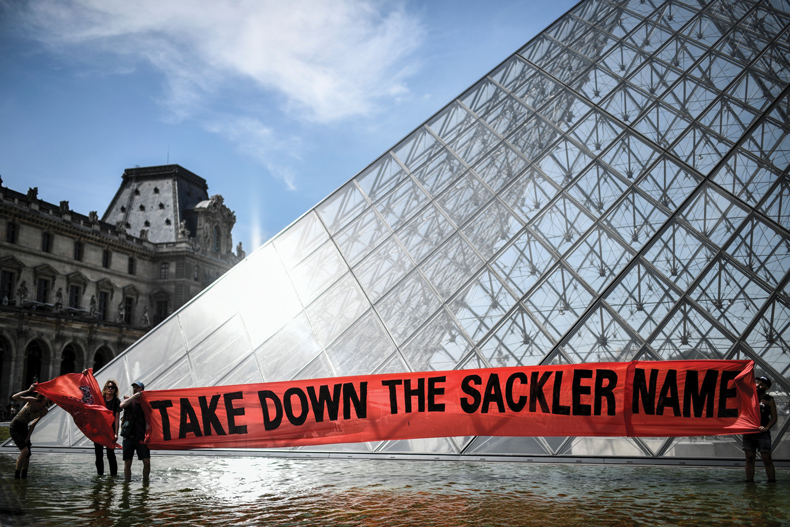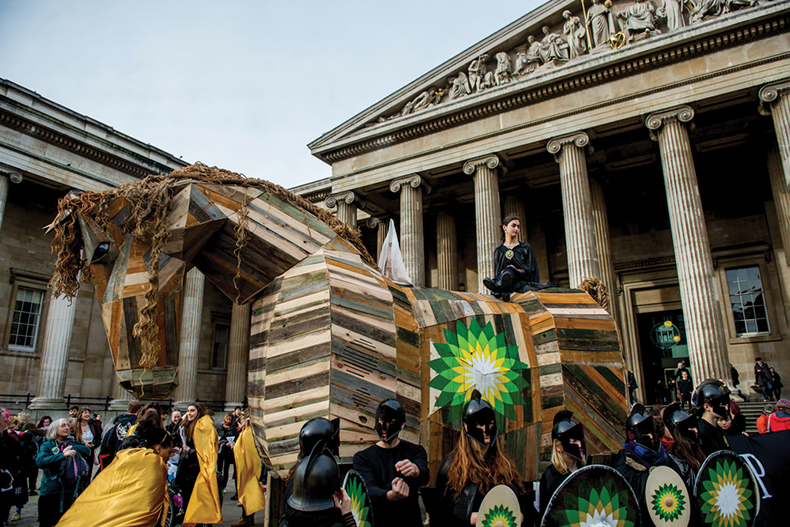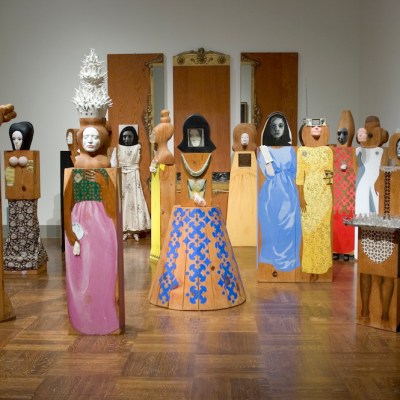From the October 2023 issue of Apollo. Preview and subscribe here.
In September, the V&A Dundee announced that it had removed the Sackler name from its walls. In so doing, it joins a number of institutions – from the National Gallery in London to the Louvre in Paris – that have deleted any reference to the dynasty indelibly linked to the global opioid epidemic, from which some members of the family profited via their company Purdue Pharma. These museums have primarily been responding to the protests led by artist and opioid addiction survivor Nan Goldin, who founded the activist group PAIN (Prescription Addiction Intervention Now). The campaign reached a climax in 2019 – but if anyone were tempted to think that it had petered out, the V&A Dundee’s actions make clear that the problem of whose money museums accept is still very much alive. Donors are under closer scrutiny than ever before – which leads to the question, who are museums now supposed to ask for money?
There are, broadly, two avenues open to museums for fundraising. They can either seek money through private philanthropy or corporate sponsorship. According to the strategy advisor Leslie Ramos, author of Philanthropy in the Arts: A Game of Give and Take, there are some differences between the two. Companies want three things: visibility, something to give their staff to keep them happy, and – above all – a place for entertaining. Ramos suggests that stipulations regarding company benefits and visibility are more likely to be written into contracts museums agree with corporations than with philanthropists. This is not to say that philanthropists don’t insist on their own conditions. ‘For example,’ she says, ‘some gifts can be restricted, meaning that the recipient needs to adhere to the use specified by the donor. Then you have unrestricted funding, which is when a donor makes a gift toward an institution allowing the institution to spend in any of their areas of need.’ Even in the latter instance, Ramos stresses that there are always strings attached – at least a ‘thank you’ or a line of acknowledgment of the support received.

It is well known that private philanthropy is particularly influential in the United States. This is in stark contrast to the ‘mixed economy’ approach in the United Kingdom. While many cultural institutions in this country try to emulate aspects of the US culture sector – including its focus on endowments – the reality is that UK museums still largely rely on the state, in common with those across much of Europe.
Yet the American model comes with its own complications. One money-making mechanism employed by US institutions that has proved particularly effective is to appoint major donors as trustees. Yet, as recent years have made clear, this makes museums vulnerable if the public turns against the industry from which that trustee made their money. Take Warren Kanders, the owner of the Safariland company that manufactures tear gas, who resigned from the board of the Whitney Museum of American Art in 2019 after protests.
Major museums in the United Kingdom have long acknowledged that private funding is now an essential part of their support system. As far back as 2008, the National Museum Directors’ Council, which represents the leaders of UK national collections and major regional museums, called for an ‘unabashed celebration of philanthropy’ – and this sentiment persists.
‘While partly supported by grant-in-aid from government […] it is essential for the National Portrait Gallery (NPG) to work with a wide range of individuals, companies, trusts and foundations in support of its activities, and as a charity, we proactively encourage philanthropic support,’ says Sarah Hilliam, the NPG’s director of development. For the financial year 2022–23, its total income was £34.2m: £18.6m came from government grant-in-aid and £15.6m from trading and fundraising.
A spokesperson for the Science Museum Group, which runs five sites including the Science Museum in London, says that this is a challenging time to raise money: ‘The pandemic, inflation and the wider cost of living crisis have all contributed to a challenging financial context for the sector and the development team tell me those same issues are factors in their work.’
The Science Museum Group has, however, been criticised by environmental campaigners for accepting donations from the Anglo-Dutch oil group Shell. The oil company British Petroleum (BP), another object of ire, began a sponsorship partnership with the British Museum in 1996 (the then-CEO of BP, Lord Browne, was appointed a trustee of the British Museum in 1995). The company has continued to co-fund major exhibitions – including ‘Hieroglyphs: Unlocking Ancient Egypt’ in 2022. The conglomerate’s most recent five-year deal ended in February, and there were excited press reports in early June that the relationship had ended – though the museum swiftly responded that no decisions have been taken about its relationship with the energy giant. Many other arts institutions that have received funding from BP have, however, severed ties – including the NPG, which announced in February 2022 the end of a relationship that had lasted more than 30 years.
In the UK arts sector, the name of Ukrainian-born businessman Leonard Blavatnik has become ubiquitous. Among his many high-profile acts of philanthropy, he gave £50m towards Tate Modern’s extension – the Blavatnik Building – which opened in 2016. The NPG accepted a £10m gift from the foundation set up by Blavatnik. He made his fortune in the aluminium and oil business in the 1990s, something ignored by museum chiefs. Writing in the Times last December, Richard Morrison vouches for the man: ‘I have no idea what motivates Blavatnik to give, but I despair at the background murmur of snide comments whenever he donates to the arts.’
Blavatnik is by no means the only major donor to face such opprobrium. In the Guardian earlier this year, Hannah Jane Parkinson criticised the Denise Coates Exhibition Galleries at the Courtauld in London. Coates founded an online gambling company, Bet365. Parkinson refers to Public Health England data showing that 2.2 million people in the UK are either problem gamblers or at risk of addiction.
It is not only the present era that considers donations from certain quarters to be unacceptable. In 1984, an exhibition of works by George Stubbs at the Tate was sponsored by United Technologies, then a major contractor to the US military, sparking a debate about donor ethics. Tate subsequently declared that ‘it should not accept sponsorship from arms dealers’ in 1991.

Both the NPG and Science Museum Group point to rigorous ethics codes and policies in relation to donors, which have become the norm for museums in the United Kingdom and the United States. But the ramifications of accepting philanthropy from individuals or companies who are publically perceived as toxic – especially in the wake of the furore over the Sacklers – are far-reaching. On a basic level, the Sackler row means the removal of a major player in an increasingly shrinking pool of cultural philanthropists. According to Nicole Newman, a London-based fundraising consultant who supports arts organisations, ‘The worrying thing is that there don’t appear to be many replacements. The younger generation of philanthropists are focusing their giving on major global challenges from the climate crisis to the cost of living,’ she adds.
The bigger picture is challenging. ‘There’s less philanthropic money around and [institutions] need to work a lot harder to engage new donors and this will require a more balanced approach to ethics. There is no such thing as “pure” private funding. If you dig deep enough, anyone who’s made a lot of money is likely to have some skeletons,’ Newman says.
Maxwell Anderson, president of the Souls Grown Deep foundation – a non-profit organisation dedicated to promoting the work of Black artists from the American South – says of the Sackler fallout: ‘Leading museums are now conscious of sources of wealth as never before, and potential supporters are thinking twice about donations if the origins of their affluence may elicit protest. This has clogged the philanthropic pipeline in some instances and “artwashing” is no longer a guaranteed tactic for social acceptance.’ Artwashing – using cultural philanthropy to distract from dubitable business activity – is a charge often directed at donors hoping to detoxify their brands.
A statement given by the British Museum in 2021 praised BP for providing ‘support for galleries, education facilities, curatorial posts and research projects […] Without external support much programming and other major projects would not happen.’ As state funding dwindles, UK museums – which as a rule do not charge entrance fees – are facing a serious dilemma. ‘While it might be justifiable to refuse funding from unethical sources,’ Ramos says, ‘the questions for art organisations remain – who will step in to fill the gap? In many of the cases where arts organisations have received funds from questionable sources, the public has cared little.’ So where next for embattled arts institutions? Asked if the NPG anticipates a drop in private funding, Hilliam says that it is ‘fortunate in [its] support from long-standing partners, as well as a new generation of supporters’. A curator at another UK national museum, who prefer to remain anonymous, says: ‘We don’t anticipate a drop in private funding, but we are apprehensive of the next [government] Spending Review, which is scheduled to occur after the next general election [expected in 2024].’
Benjamin Soskis, a senior research associate at the Center on Nonprofits and Philanthropy at the Urban Institute in Washington, D.C., says: ‘I think moving forward there is going to be an expectation that the donor relationship is less transactional and has a larger moral identity. I think the institutions increasingly are going to have to try to make a compelling case why donors actually fit into their moral purpose and identity beyond just the fact that they are rich and can give them money.’
He notes also an increase in ‘morals clauses’ adopted by US museums, which protect them to a degree if donors fall from grace. ‘I’m particularly interested in time limits incorporated into contracts as a kind of mechanism to potentially inoculate an institution from learning about donors that they didn’t realise were toxic but are toxic,’ he says. Soskis believes the ‘boundary conditions’ for toxicity are still unfurling. ‘My sense is that the Sackler affair has not reached a kind of definite resolution in that it’s still not clear to me the extent to which the Sacklers will be interpreted as a kind of exceptional case.’
Newman believes the donations model needs to change, suggesting that the future is in partnerships – ‘proper “joint ventures” with other organisations, be it education, government, third-sector charities, or other cultural organisations, as well as corporate businesses or philanthropists. This is different to traditional sponsorship or fundraising where a business or supporter is offered an existing project in return for a specific set of assets […] genuine partnerships require shared creation, objectives, responsibilities, values and of course shared resources, reducing the costs for individual organisations.’
At the heart of the matter is the question of whether museums should lead public morality or follow it. ‘Unless museum leaders grapple earnestly and visibly with the impact of every key decision, their institutions will suffer as a consequence,’ Anderson says. Museums need to ensure they are not pushed around by the morals of the day but instead take a long-term view, says Newman. With the fall from grace of donors such as the Sacklers, the standing of museums has diminished by proxy. But if they can begin making more ethically sound decisions as to the sources of their funding, they should be able to restore at least a modicum of public confidence.
From the October 2023 issue of Apollo. Preview and subscribe here.


